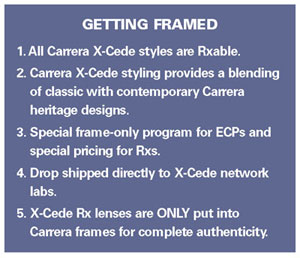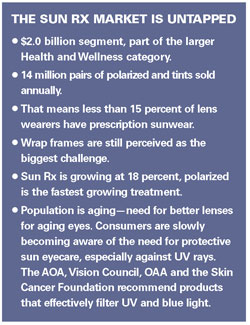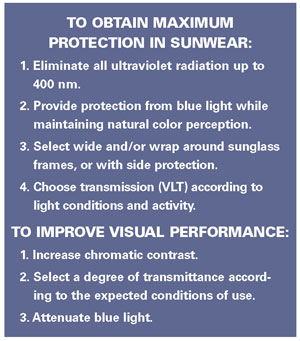Invisible Technology You Can See
Color enhancing, high contrast, polarizing sun lenses
By Mark Mattison-Shupnick, ABOM
Release Date: March 1, 2012
Expiration Date: February 15, 2017
Learning Objectives:
This CE course reviews the vision enhancing technology that is at the core of the Carrera X-Cede collection. Upon completion of this program, the participant should be able to:
- Understand the unique technologies incorporated into this new proprietary collection.
- Understand the advantages of sun lenses that feature high contrast definition vision.
- Understand the benefits of the new non-film polarization technology incorporated into this lens.
Faculty/Editorial Board:
 Mark Mattison-Shupnick, ABOM is
currently director of education for
Jobson Medical
Information LLC, has
more than 40 years
of experience as an
optician, was senior
staff member of
SOLA International
and is a frequent lecturer and trainer.
Mark Mattison-Shupnick, ABOM is
currently director of education for
Jobson Medical
Information LLC, has
more than 40 years
of experience as an
optician, was senior
staff member of
SOLA International
and is a frequent lecturer and trainer.
Credit Statement:
This course is approved for one (1) hour of CE credit by the American Board of Opticianry (ABO). Course STWJM504-2
 Consumers today expect and demand high-tech and high performing products that satisfy our needs, requirements
and are just plain cool. Sometimes that promise is not met, even with higher priced products, especially in sunglasses.
Consumers today expect and demand high-tech and high performing products that satisfy our needs, requirements
and are just plain cool. Sometimes that promise is not met, even with higher priced products, especially in sunglasses.
We have seen dramatic changes in most of the products we use daily—TV, phones, cars, cameras, etc. The first car phones had wires and antennae; mobile phones were huge and heavy; then cell phones could text and take pictures. Smart phones like iPhones and Androids are now the norm, and we want even more… Would we ever go back?
So why isn't it the same for sunglasses? I contend that sunglass lenses basically have not changed for years. Of course, there have been new materials, i.e., better mirror coatings, high performing photochromics with better AR and durability, etc. However, what about viewing through the lens? Why are lenses with contrast and color enhancements standard so the vision through sun lenses is better color tuned?
Introducing the Carrera X-Cede collection by Sàfilo, sunglasses made from a new, unique and proprietary sun lens manufacturing process that uses high contrast definition technology to create sun lens color enhancements in a non-film polarizing lens.
TWO THINGS
There are two things quality sunglasses should do for patients. First, they must enhance and protect vision. Next, they should look good and feel comfortable when worn.
According to Al Gleek, president of AG Vision Consulting, LLC, a company providing technical and strategic marketing programs focused on sunwear: "When Sàfilo set out to design its new sunglass collection, the goal was to exceed both of these basic criteria. The style and design heritage of Carrera provided a perfect starting point for the look and fit of the collection. Exceeding the first criteria of enhancing and protecting vision provided a unique opportunity for a traditionally frame-first company to reimagine their role in developing cutting-edge lens technology for their collection." Their efforts resulted in the successful introduction of the new Carrera X-Cede collection.
THE CORE FUNCTION
The core function of sun lenses is to condition light, modifying incoming light to enable clearer and more comfortable sight for the wearer. In one sense, sun lenses are very much like a water filter that removes bad elements and contaminates, and allows good water and minerals through. The purity of the water that passes from the filter effectively enhances the final product.
Similarly, sun lenses filter different wavelengths and types of light with the goal to provide the clearest vision possible to the wearer.
As with the water filtration example, there is precisely filter or control the light optimizes vision and enhances the overall visual experience for the wearer.
ELIMINATE THE BAD, ENHANCE THE GOOD
 Prolonged exposure to UV light damages the cornea, lens and retina. The first step in eliminating the bad is to block 100 percent UVA/UVB radiation. All lenses prescribed to the patient—whether clear, photochromic or sun lenses—should protect against UV radiation. Every Carrera X-Cede lens automatically provides 100 percent UV protection.
Prolonged exposure to UV light damages the cornea, lens and retina. The first step in eliminating the bad is to block 100 percent UVA/UVB radiation. All lenses prescribed to the patient—whether clear, photochromic or sun lenses—should protect against UV radiation. Every Carrera X-Cede lens automatically provides 100 percent UV protection.
In addition to protecting against UV rays, X-Cede sunglasses provide protection from intense light. As the eye receives light, it naturally opens and closes the iris to adjust the amount of light that is passed on to the retina. If the light is extremely intense and the iris has closed as far as possible—approximately 2 mm in diameter at its smallest—the physiological response is to squint. Extended periods of squinting can cause significant eyestrain and fatigue. To reduce eye fatigue and provide more comfortable vision in outdoor light, tinted and polarized sun lenses reduce or filter the overall amount of light that is transmitted to the eye.
To further enhance visual comfort and acuity, X-Cede lenses go two steps further by eliminating specific frequencies of light and highlighting others. Certain frequencies of light blur vision, while others enhance contrast. To understand how X-Cede lenses incorporate this precise control of light, it is important to start with a base level understanding of how the human eye functions and how we perceive color.
Our eyes are stimulated by the visual spectrum—electromagnetic radiation from 400 nm to 700 nm— and contain different color sensitive retinal receptors. There are three polychromatic receptors called cones, which are stimulated to generate an electric signal based on certain wavelengths and intensities of light. These three types of cones define our vision as "trichromatic." The interaction of the electric signals that these cones send to the brain through the optic nerve is necessary to produce the ability to perceive color. The three types of cones are Short (420 to 440 nm), Medium (530 to 540 nm) and Long (560 to 580 nm). (Fig. 1) The increased ability to perceive more colors from this overlap is advantageous. Any wavelength of light from 420 nm to 660 nm will produce a unique set of responses that combines all three cone types.
Each of these receptors will not just respond strictly to light within its target wavelength range. A receptor’s sensitivity curve is broader and actually overlaps parts of the other receptor’s sensitivity curves. Because of this overlap, our vision can enjoy a much larger range of colors than otherwise would be the case if these receptors only responded to their primary wavelength range. (For more information see "Avoid (S)Unfamiliarity: Only Use Smart Sunglasses" at 2020mag.com/CE)
 But the advantage of enjoying a large variety of colors is accompanied by a disadvantage: a decrease in our ability to rapidly discriminate color borders, or edges, in the receptor overlap areas. The ability to discriminate colors is referred to as "chromatic contrast," and is essential toward understanding how different color tints in sunglasses can enhance our visual response. To accomplish this goal, X-Cede lenses incorporate a proprietary complex of High Contrast Definition (HCD) dyes to selectively filter light in two unique ways. By managing the "visual peaks and valleys" that "pop" and deliver dynamic color enhancing properties, X-Cede lenses pinpoint spectral management (Fig. 2). Wavelengths that cause visual noise are eliminated, while the wavelengths that enrich color, clarity and detail shine through.
But the advantage of enjoying a large variety of colors is accompanied by a disadvantage: a decrease in our ability to rapidly discriminate color borders, or edges, in the receptor overlap areas. The ability to discriminate colors is referred to as "chromatic contrast," and is essential toward understanding how different color tints in sunglasses can enhance our visual response. To accomplish this goal, X-Cede lenses incorporate a proprietary complex of High Contrast Definition (HCD) dyes to selectively filter light in two unique ways. By managing the "visual peaks and valleys" that "pop" and deliver dynamic color enhancing properties, X-Cede lenses pinpoint spectral management (Fig. 2). Wavelengths that cause visual noise are eliminated, while the wavelengths that enrich color, clarity and detail shine through.
The benefit of this invisible technology is clearly seen through the eyes of the wearer. The precise control, absorbance and elimination of "bad" light (or distracting, confusing visual noise) and the enhancement and highlighting of "good" light allow the wearer to discriminate colors more accurately and improve overall visual experience.
NON-FILM POLARIZATION PLANOS
To truly enhance and protect vision, sunglasses should provide protection from glare. Certain surfaces, such as water, can reflect a great deal of light, and the bright spots can be distracting or can hide objects. Quality sunglasses can completely eliminate this kind of glare using polarization.
The vast majority of polarized lenses use a premade, embedded, polarizing film to reduce and/or eliminate glare. In most lenses the film is curved, bent and stretched to accommodate the lens base curve and size. This bending and curving potentially reduces the polarization efficiency and can cause distortion and warp
less common today, delamination, cracking and crazing can occur with some traditional film depending on the method used in manufacturing—bonding, laminating and thermoforming.
Utilizing a revolutionary non-film polarization process, plano X-Cede lenses eliminate most, if not all, potential drawbacks of traditional polarized lenses especially when compared to "cheap" polarized plano sunglasses. This proprietary process results in 98 percent edge to edge polarization efficiency so there is no reduction in the glare filtered. This is not a stretched film so it avoids warping or waves that may become part of the lens during manufacturing. The lens itself becomes polarized through the process with the polarizing elements molecularly bonded on the back surface of the lens. This eliminates the threat of delamination, cracking and crazing (Fig. 3).

CONTRAST DEFINITION
Since the eye responds to certain wavelengths that are filtered or transmitted, the VLT (Visible Light Transmission) chart provides a graphic illustration of the design of sunglass lenses, where harsh or non-beneficial light is reduced or eliminated and where the richness, color clarity and detail are enhanced. This can improve our vision and provide visual benefits when viewing objects and participating in lifestyle activities.
X-Cede lenses selectively filter light in two unique ways. The specific points referenced in the VLT chart (Fig. 4) were chosen to provide visual peaks and valleys that pop and deliver dynamic color enhancing properties of X-Cede lenses. The unique capability of NXT technology provides pinpoint spectral management and visual enhancement.


BUILT ON A STRONG FOUNDATION
 X-Cede lenses are built on NXT sun lens technology. NXT technology is a combination of Trivex material and light-control technologies that enhance clarity, improve comfort and protect vision in all light conditions. To enhance clarity, this material has a high Abbe, accepts the best scratch and AR coatings, and is highly compatible with digital (free-form) surfacing processes. To deliver improved comfort, this material produces lighter weight and thinner polarized lenses. To protect the eyes
and vision, the material is highly impact resistant, controls glare and blocks UV and High Energy Visible Light (high energy blue light).
X-Cede lenses are built on NXT sun lens technology. NXT technology is a combination of Trivex material and light-control technologies that enhance clarity, improve comfort and protect vision in all light conditions. To enhance clarity, this material has a high Abbe, accepts the best scratch and AR coatings, and is highly compatible with digital (free-form) surfacing processes. To deliver improved comfort, this material produces lighter weight and thinner polarized lenses. To protect the eyes
and vision, the material is highly impact resistant, controls glare and blocks UV and High Energy Visible Light (high energy blue light).
During the X-Cede lens manufacturing process, the base Trivex material is infused with the HCD dye package prior to casting. This results in an enriched Trivex material solution that inherently becomes the desired color. When the lens is cast, cured and removed from the mold, it has all of the desired light filtration and control characteristics. There are no dyes applied externally to the lens. X-Cede sun lenses achieve their High Contrast Definition properties in-mass during the production process. In-mass tinting provides a consistent color throughout the entire lens—there are no pockets of color or splotchy areas as are sometimes seen in lenses that are tinted using a dye bath and/or tintable hardcoat layer.
MEET/EXCEED EXPECTATIONS
Replicating the look and performance of plano sun lenses has been difficult in Rx lenses. That's because different semi-finished blanks and processes have had to be used versus that of plano lenses featured in high performance sunwear. Using the NXT technology platform, the same performance, attributes, benefits, color and contrast enhancement of X-Cede plano lenses are available in authentic X-Cede Rx lenses.

Since the polarized surface is effectively on the lens front surface (within a few microns), NXT Trivex lenses can be surfaced thinner. The lab doesn't have to worry about grinding through an embedded polarizing film.

There are two key elements of the X-Cede Rx program that make it truly authentic. First, Carrera brand sunwear uses proprietary X-Cede lens blanks for Rx, not available in any other brand. These high performance Rx lenses are only available through an X-Cede authorized laboratory network and professional, optical authorized retailers. Second, X-Cede Rx lenses are available in polarized digitally enhanced single vision and progressive lens designs to deliver the exact benefits of X-Cede technology customized for prescriptions. Check with the lab network for availability of Essilor, SOLA, Shamir and proprietary lab designs. Plus Carrera X-cede Rx lenses come standard with back surface AR and oleo/ hydrophobic front surface coatings to deliver the ultimate in sun and Rx performance.

CONCLUSION
Carrera X-Cede sunwear incorporates a new, proprietary sun lens manufacturing process that uses high contrast definition technology to create sun lens color enhancements in a non-film polarizing lens. The Carrera X-Cede collection features three high contrast definition colors with 98 percent polarizing efficiency. Powered by NXT technology and made with Trivex material, X-Cede sun lenses are lightweight, highly impact resistant and visually clear. This provides eyecare professionals with the opportunity to add a product with benefits a patient can clearly see.



